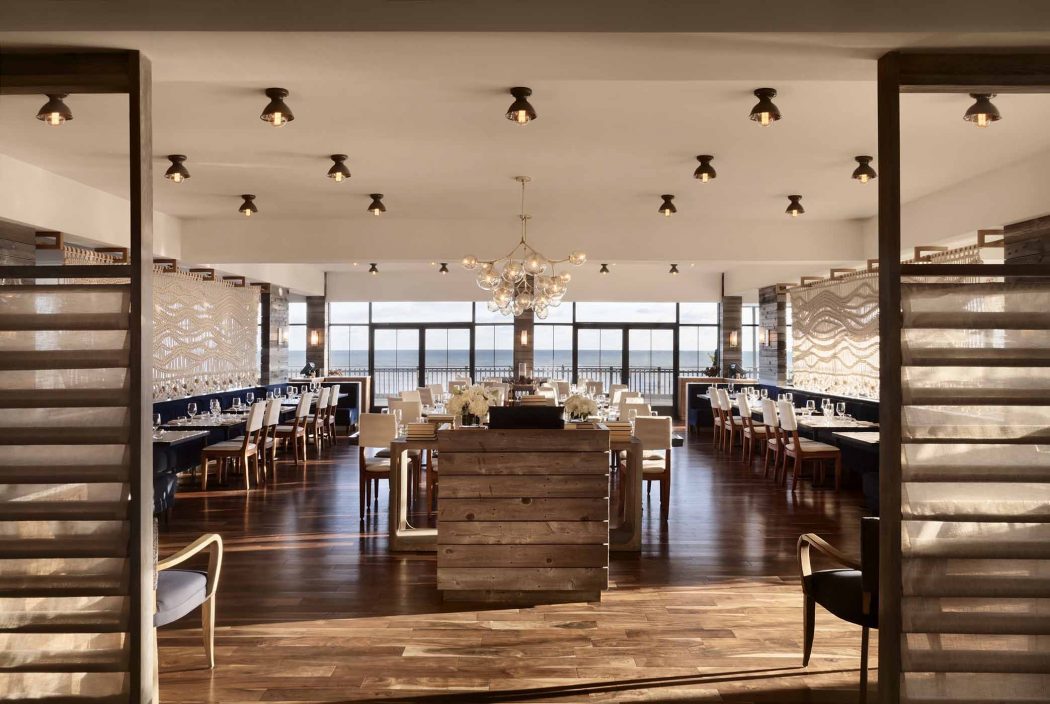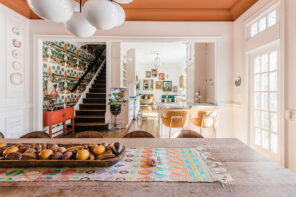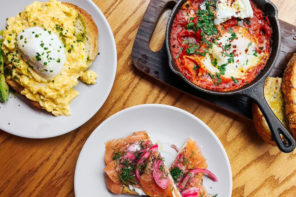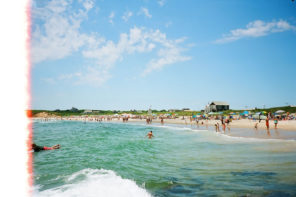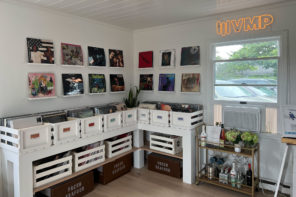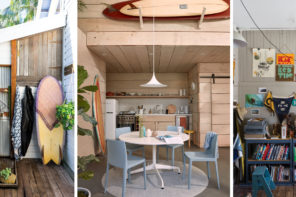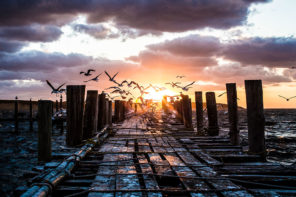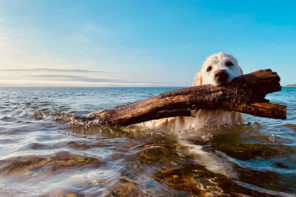When 88-year-old Montauk hotel Gurney’s Inn reopened in 2014 as Gurney’s Montauk Resort & Seawater Spa, people were paying attention.
But the attention to detail was all in the hands of interior designer Michael Kramer, now 30, who (to the tune of $5 million) transformed the dated seafront resort into one of the most sought-after spots on the East End.
Recently I caught up with the designer and founder of Michael Thomas & Co. to discuss his vision for Gurney’s Montauk, the behind-the-scenes scoop and the craziest places he drew inspiration from.
What drew you to working with Gurney’s?
I got the job very randomly. When I left King & Grove — which was an amazing experience — George, the owner of Gurney’s reached out to me.
Actually, when he called me I didn’t think it was real. I thought it was a friend pranking me! A deep voice on the other end said, “This is George Filopoulos” and he told me he was opening a hotel. I was thinking, “Nobody is going to give a 26-year-old a hotel.” But at the last minute I thought, I should probably Google this guy. He was real!
So I called the private dinner club I was supposed to meet him at and the hostess confirmed George had reserved a table for two for that night. I thought, Oh, crap! I was in jeans and sneakers and this was a private club that required jackets. I didn’t have time to go the store and buy something quickly enough, so I called a friend who is very connected and she helped me out. When I walked in, the hostess was giving me the look of death and everyone was staring at me.
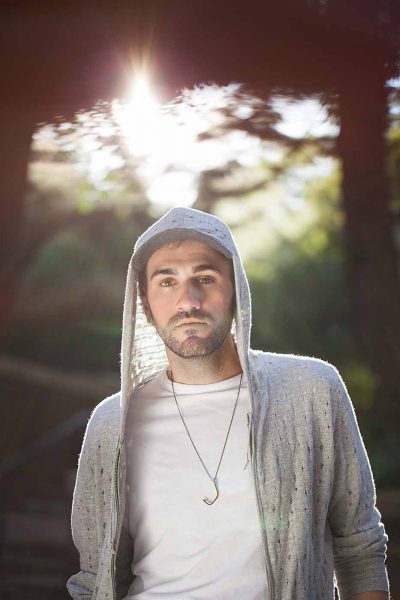
“Clothes!” Photo: Jeremy Powitz.
George’s first question was “What are you wearing? I’m a member here and I can’t walk in like that.” I was like, “Clothes!” That was it. I was hired.
Did you draw inspiration for the design at Gurney’s from any unusual sources?
I draw a lot of inspiration from humor and from life. For example, I wanted to do a huge Macrame hanging in Scarpetta Beach. I wanted something retro and good for Instagram and… well, George doesn’t really know design, but I was swamped and he was trying to help me. So I asked him to order me some Macrame and gave him a contact. He calls up someone on Etsy and tells him “My designer wants Macaroni… I don’t know. It’s an Italian bar. It’s weird but that’s what he wants.”
So this woman calls me… “You want macaroni woven together?” It was so funny. So I decided to make the lights in Scarpetta Beach look like pasta bowls. We created these beautiful light fixtures that look like upside down bowls of pasta.
For Gurney’s, specifically, my inspiration was the place itself. It’s been there forever, 90 years, and my whole concept for the space was a room in a time share. That’s what Gurney’s originally was. We tried to create a room which had collected something from every decade and then we designed it in a new way. So we have a 1930’s Chippendale dresser that we put very modern handles on so that it doesn’t look like it’s from the ‘30s but it’s nostalgic.
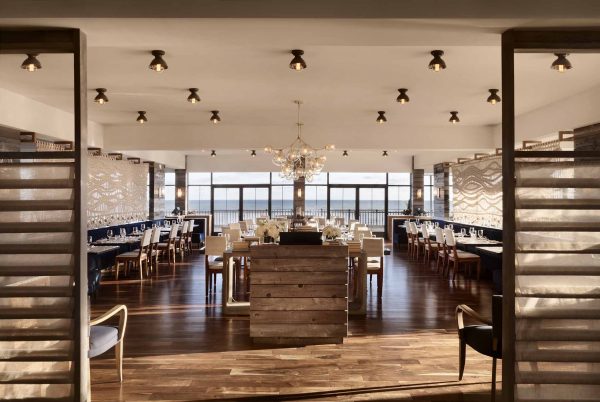
Scarpetta Beach. Photo: Jeremy Powitz
What were some of the challenges you faced executing the final vision?
There were definitely challenges! I wanted wood floors at Gurney’s and they told me, “No you can’t do wood floors on the beach.” I said, “There can’t be ‘no’ with this.” So the floors we developed for the guest rooms have a diamond and sapphire finish. We spent months developing them. They will whether and age but they won’t deteriorate or rot away.
And then, in the first renovation, a truck got into an accident and damaged some minibars and lights. It was two days before Memorial Day weekend and we were sold out! And I’m at West Elm asking, “What do you have at this store? I’ll take anything.” George (again, amazing client) is on the headset saying, “Room 301 needs a lamp!”
But if you’re a designer who is very stuffy and you can’t adapt, if something happens like that, it’s over. But if you’re able to look at the bright side and laugh and move on… it’s how we adapted as a team and moved forward that made it successful.
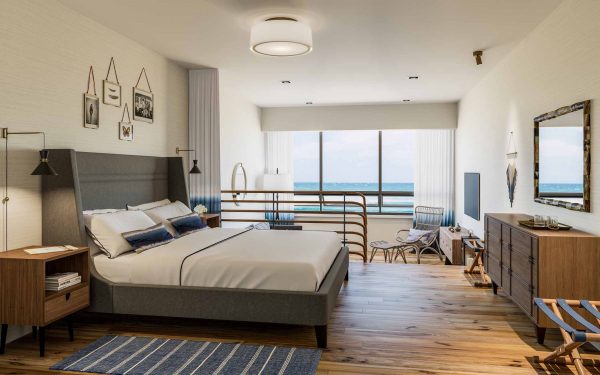
Kramer’s Oceanview Guest Room. Photo: Gurney’s
How did you get started in interior design?
I’ve been doing interior design since I was seven. My family purchased a home that we were going to flip or sell and I was going to Home Depot picking out counters. My parents are amazing — and they let me just do that.
Every time I would get a good report card I would ask for a new front door or a rock garden. I feel like I’ve been doing that forever.
Then when I was 17, a friend’s family owned a bar in Long Island, where I’m from, and they wanted me to come look at it. I ended up designing their bar and I didn’t really know anything about where to get stuff so it was a lot of Home Depot and Ethan Allen — stuff you don’t put in a bar.
I went on to work in restaurants and enrolled at New York School of Interior Design. Then
I got an internship at King & Grove Hotel where I worked as an intern for two or three days and then I just started re-organizing the office. The CEO was like, “Who are you?” I ended up getting a job quickly and I got to work with the very designers I was learning about in school. It was fantastic. I stayed for a while and ended up working on 18 hotels.
When designing Gurney’s, in what ways did you keep Montauk culture in mind?
I think a designer who really wants to do something that makes both the locals and the visiting guests happy is to know the neighborhood. I’ve been very fortunate to work in Montauk a number of times. You have to go out and go to the places everyone’s at like Liar’s or Harvest. You have to talk to locals and ask them, “Hey, why don’t you go to this place?” They’ll tell you, “We don’t like those people, they wear fedoras.” So you don’t have your staff wear fedoras! You don’t want to insult the locals. The best thing about working out in Montauk? The people are SO nice.
I don’t want to make something bougie. I want locals to come and bring their kids and surf and go to the spa and hang it the lobby like it’s their living room. Out in Montauk, specifically, I got to go to some amazing artists’ homes. People invited me into their homes and art studios to see how they think and how they create and the inspiration from that alone.
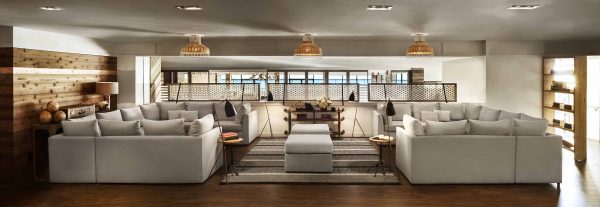
The main hall and living room. Photo: Jeremy Powitz
You should always respect the neighborhood you’re doing a project in and the people in it.
What is your perception of the changes happening in Montauk right now?
Montauk has two different cultures right now. The most interesting is the real, local culture. They are extremely nice people but they are so confident in themselves and so genuine. There is a loyalty to common decency.
Then you have the people who come in just for the summer, and it’s trust fund kids. I think that will last a while in Montauk — and, eventually, go somewhere else. But Montauk locals feel they will survive it.
What is your philosophy as a designer?
My company is called Michael Thomas & Co. because Thomas is my middle name and I don’t want it to be all about me. Someone took a chance on me, many people did. So I take chances on people.
We don’t have a traditional “office” at the company. We have a good time, we go out and we have fun. My biggest thing is that life is so… you don’t know. It’s short. If you found a job that you love, and you love what you love to do, then you should be so proud. For me, I am inappropriate in meetings. I am fun! I want my client to be happy but I am me.
What’s next for you?
My biggest goal is to create a line of items and homeware that people can afford. I’ve been working with a pretty large company on developing that.
The next step is a second, amazing hotel in New York State, a sprawling property. I fell in love with this place because it reminds me very much of Montauk. Fingers crossed that will be my next big project.
Keep up with Michael Kramer and his projects on Instagram @michaelthomasandco, or have your eyes head over to the Michael Thomas & Co. website. If you enjoyed this interview, check out our chat with Robert McKinley, designer behind both Surf Lodge and Ruschmeyer’s.

